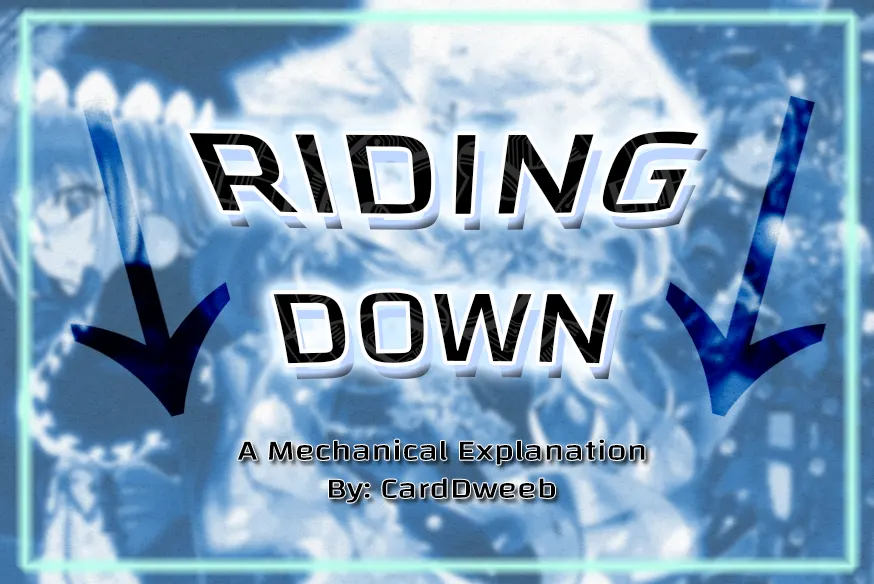
Riding Down
A Mechanical Explanation and Discussion About Riding Down in Premium
| Febuary 19, 2023
The Basics of Denying Stride
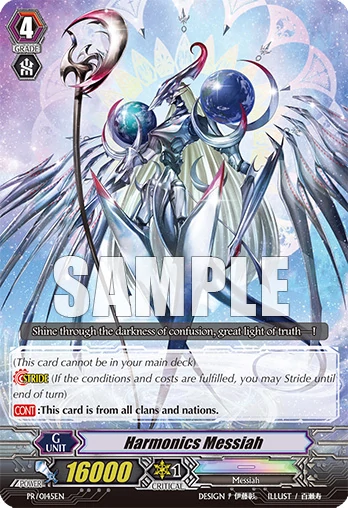 Stride is a mechanic that allows you to place a Grade 4 unit from your G Zone - an extra deck - on top of your Grade 3 or greater vanguard for an additional 15,000 power buff, triple drive, and additional abilities.
Any abilities on the Heart Card - the card under the Stride - cannot be activated.
The Stride also inherits the Heart Card’s name and power, making name-locked cards still functional.
However, the condition to Stride requires either you and your opponent to be at Grade 3 during the Stride Step or be at Grade 3 at the start of your turn.
With the current Stride rules, your opponent must be at Grade 3 when you ride up to Stride or you must superior ride to Grade 3 and stay on it for a turn before Striding.
Superior riding to Grade 3 is the only alternative way of Striding early, but decks that superior ride tend to either have weak hand advantage or their strides don’t do enough to warrant superior riding.
Stride is a mechanic that allows you to place a Grade 4 unit from your G Zone - an extra deck - on top of your Grade 3 or greater vanguard for an additional 15,000 power buff, triple drive, and additional abilities.
Any abilities on the Heart Card - the card under the Stride - cannot be activated.
The Stride also inherits the Heart Card’s name and power, making name-locked cards still functional.
However, the condition to Stride requires either you and your opponent to be at Grade 3 during the Stride Step or be at Grade 3 at the start of your turn.
With the current Stride rules, your opponent must be at Grade 3 when you ride up to Stride or you must superior ride to Grade 3 and stay on it for a turn before Striding.
Superior riding to Grade 3 is the only alternative way of Striding early, but decks that superior ride tend to either have weak hand advantage or their strides don’t do enough to warrant superior riding.
When denying Stride, you tend to deny the first option of Striding, which is both you and your opponent being at Grade 3 at the start of the Stride Step.
To accomplish this, you end your turn on a Grade 2 or less vanguard so that both you and your opponent aren’t at Grade 3 at the start of their Stride Step.
The main strategies to accomplish this is Ridedown and Grade 2 Gaming. Grade 2 Gaming is self-explanatory, so let’s dive into Ridedown.
What Is Ridedown?
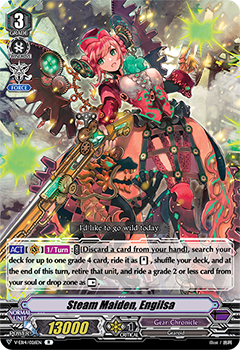 Ridedown can be described as the action of riding up to Grade 3, usually for a gift marker, then riding back down to Grade 2 or lower to deny your opponent from Striding.
This is an alternative way of Grade 2 Gaming, where you stay on Grade 2 to deny your opponent from Striding.
The whole premise of Ridedown decks is to deny your opponent the ability to Stride while gaining powerful Gift Markers for future turns.
The downside to Ridedown decks is that they do not have access to the defensive abilities of Heal Guardians, which is why Ridedown decks tend to be decks that can generate their own hand advantage easily.
Let’s look at the pros and cons of Ridedown versus Grade 2 Gaming:
Ridedown can be described as the action of riding up to Grade 3, usually for a gift marker, then riding back down to Grade 2 or lower to deny your opponent from Striding.
This is an alternative way of Grade 2 Gaming, where you stay on Grade 2 to deny your opponent from Striding.
The whole premise of Ridedown decks is to deny your opponent the ability to Stride while gaining powerful Gift Markers for future turns.
The downside to Ridedown decks is that they do not have access to the defensive abilities of Heal Guardians, which is why Ridedown decks tend to be decks that can generate their own hand advantage easily.
Let’s look at the pros and cons of Ridedown versus Grade 2 Gaming:
Ridedown
+ Generates Gift Markers
+ Has inherent hand advantage
- Turns off Heal Guardians
- Needs another G3 to ride
Grade 2 Gaming
+ Heal Guardians are active
+ Only needs one G3 to ride
- Inherently weaker than a G3 turn
- Weaker hand advantage
Usually, these strategies are interchangeable within Premium’s ever-changing environment.
However, with the recent spike in Ridedown decks, players have begun to see Ridedown as an oppressive force in the meta.
In this article, I want to explain why they aren’t as oppressive as you might think while also highlighting the similarities it has to Grade 2 Gaming.
This is in no way a article explaining why Ridedown shouldn’t get hit, but rather a discussion and comparison in relation to Grade 2 Gaming.
Why is Ridedown Considered Oppressive?
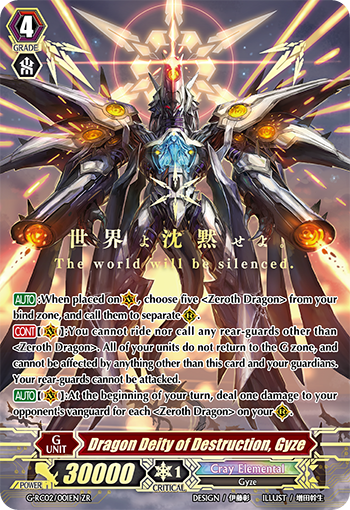 Due to the fact that Ridedown generates Gift Markers, Ridedown tends to be blown out of proportion due to the extra turns that Ridedown decks have to generate additional Gift Markers.
A good example of this would be Steam Maidens, in which Steam Maiden, Engilsa is used to Ridedown after a full turn, but only generates 1 Gift Marker for that turn.
For Steam Maidens specifically, they prefer to have 2 or more Force I Gift Markers on a single circle, so it is encouraged to Ridedown for at least a turn.
Having that extra turn to obtain another Force I Gift Marker usually lets Steam Maidens close out the game on their first stride turn.
Due to the fact that Ridedown generates Gift Markers, Ridedown tends to be blown out of proportion due to the extra turns that Ridedown decks have to generate additional Gift Markers.
A good example of this would be Steam Maidens, in which Steam Maiden, Engilsa is used to Ridedown after a full turn, but only generates 1 Gift Marker for that turn.
For Steam Maidens specifically, they prefer to have 2 or more Force I Gift Markers on a single circle, so it is encouraged to Ridedown for at least a turn.
Having that extra turn to obtain another Force I Gift Marker usually lets Steam Maidens close out the game on their first stride turn.
In a general Premium game without Stride-denying strategies, the game tends to end on the second stride turn.
This tends to be advantageous to the person who got to stride first, which is usually the person going second.
However, with the addition of Stride-denying strategies, the person going first can stride first as well if they can force the other player to stay on Grade 3 before they do.
Due to the impact of first stride turns, players take turns to force their opponent to stay on Grade 3 so that they get the first stride turn OR they ride up themselves to win the game through their Grade 3 turn.
The reason why Ridedown isn’t as oppressive as people may think is due to the anti-Ridedown strategies that exist.
If we look at a deck such as Nightmare Dolls that spam Accel II Gift Markers, their columns are generally weak.
They sacrifice more power for more attacks, with most of the attacks not being able to hit over a defensive.
However, they cannot pressure if the opponent stays at Grade 2 and can reliably obtain Heal Guardians to shut down their turn.
Of course, this is a generalized comparison, but anti-Ridedown strategies exist and they keep Ridedown decks in check.
Anti-Ridedown Strategies
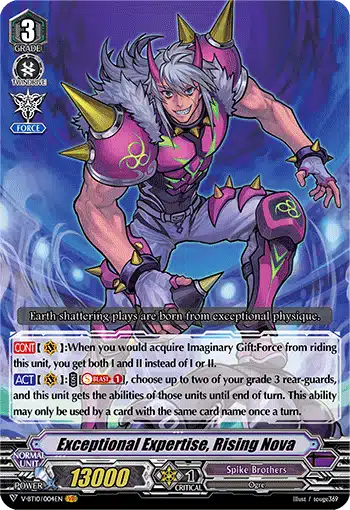 Due to the lack of defensive Heal Guardians, Ridedown decks are forced to guard manually and hope for defensive triggers.
Due to this, they can’t shut down a turn with a lot of small attacks without hitting a defensive trigger.
Alternatively, they cannot guard larger attacks as easily without Heal Guardians, so they are forced to use Sentinels to guard said attacks.
This reduces their defensive capabilities, but that’s why the main Ridedown decks in the current meta are decks that can obtain a lot of hand advantage.
As such, here are a few strategies for dealing with Ridedown decks.
Due to the lack of defensive Heal Guardians, Ridedown decks are forced to guard manually and hope for defensive triggers.
Due to this, they can’t shut down a turn with a lot of small attacks without hitting a defensive trigger.
Alternatively, they cannot guard larger attacks as easily without Heal Guardians, so they are forced to use Sentinels to guard said attacks.
This reduces their defensive capabilities, but that’s why the main Ridedown decks in the current meta are decks that can obtain a lot of hand advantage.
As such, here are a few strategies for dealing with Ridedown decks.
Force Clans or Decks w/ Large Numbers
• Gain as much advantage as you can
• Deny CB to turn off big plays
• Ride up to cripple/kill
• Make the game as short as possible to avoid Force generation
Accel/Protect Clans or Decks w/ Low Numbers
• Rush as much as you can
• Retire RGs if possible
• Stay on G2 to use Heal Guardians
• Prolong the G2 game until you know you can win
Ride up strategies are the more prevalent methods for dealing with Ridedown decks, as most of the meta at the current moment are Force clans.
Due to this, they need the game to end sooner rather than later.
Prolonging the game results in too many Force markers to feasibly guard, especially on stride turns.
As you can see from the lists, the method you use to counter Ridedown decks is different based on what kind of deck it is.
For more multi-attack-centric decks that have lower numbers, Grade 2 Gaming is better as you have access to your Heal Guardians, which tend to shut a whole turn down.
Having more than one definitely stops all pressure from your opponent’s side and puts the advantage back in your favor.
Due to this, Force decks or decks with larger numbers are doing better because they don’t have trouble with Heal Guardians on their turn.
However, they cannot use Heal Guardians back at their opponent, leaving them susceptible to rush.
Ridedown Still Needs to Get Hit!
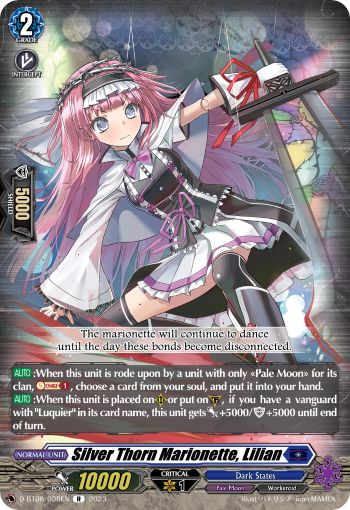 I personally think Ridedown decks should get hit in some fashion, whether it be hitting the main Ridedown decks or changing the Stride rulings to “if your opponent’s Vanguard has been Grade 3 this fight, and you are at Grade 3, you can Stride.”
However, Ridedown decks do not immediately impose an insurmountable threat to the meta of Premium and are able to stay for a few more months.
I think building around a Ridedown meta adds some new scenarios that we haven’t seen before and I welcome the new experiences with open arms.
I personally think Ridedown decks should get hit in some fashion, whether it be hitting the main Ridedown decks or changing the Stride rulings to “if your opponent’s Vanguard has been Grade 3 this fight, and you are at Grade 3, you can Stride.”
However, Ridedown decks do not immediately impose an insurmountable threat to the meta of Premium and are able to stay for a few more months.
I think building around a Ridedown meta adds some new scenarios that we haven’t seen before and I welcome the new experiences with open arms.
A Ridedown meta also allows V decks to shine with their strong Grade 3 turns alongside strong Strides if they can survive until then.
This allows for more viable decks than before and allows V players to easily transition into the Premium scene.
The only unfortunate thing is that the 2 biggest Ridedown decks at the current moment - Highlander and Steam Maidens - are also very strong in V, so they are also competing on the same level as other V decks.
However, once Ridedown decks are not good in V, such as Nightmare Dolls, Ridedown decks become a lot easier to deal with and can easily be played against using a V deck.
The OverDress meta has not gotten to the point where their decks can viably play against the current Premium decks, but their support can definitely be splashed into a lot of Premium decks; either for specific D bosses or in generic Premium archetypes.
A great number of D cards are starting to see use with the release of D Set 8, especially with the addition of Silver Thorn Marionette, Lilian.
I highly suggest looking around the D card pool to find a hidden gem waiting to be put in your Premium deck!
Afterword
Thank you for reading this document that I spontaneously decided to put together after reading a discussion about the lack of resources for Premium. I wanted to do this in video form but I found myself better at writing documents than making an informative video, so feel free to take information from this document to expand on or make a video on it! I kind of rambled on for the last page there as I wanted to say some things but didn’t know how to title the page.
If you have any questions or want to point something out that I’ve incorrectly said, you can find me on Twitter or on Discord!
Discord: CardDweeb#9519
The Basics of Denying Stride
![]() Stride is a mechanic that allows you to place a Grade 4 unit from your G Zone - an extra deck - on top of your Grade 3 or greater vanguard for an additional 15,000 power buff, triple drive, and additional abilities.
Any abilities on the Heart Card - the card under the Stride - cannot be activated.
The Stride also inherits the Heart Card’s name and power, making name-locked cards still functional.
However, the condition to Stride requires either you and your opponent to be at Grade 3 during the Stride Step or be at Grade 3 at the start of your turn.
With the current Stride rules, your opponent must be at Grade 3 when you ride up to Stride or you must superior ride to Grade 3 and stay on it for a turn before Striding.
Superior riding to Grade 3 is the only alternative way of Striding early, but decks that superior ride tend to either have weak hand advantage or their strides don’t do enough to warrant superior riding.
Stride is a mechanic that allows you to place a Grade 4 unit from your G Zone - an extra deck - on top of your Grade 3 or greater vanguard for an additional 15,000 power buff, triple drive, and additional abilities.
Any abilities on the Heart Card - the card under the Stride - cannot be activated.
The Stride also inherits the Heart Card’s name and power, making name-locked cards still functional.
However, the condition to Stride requires either you and your opponent to be at Grade 3 during the Stride Step or be at Grade 3 at the start of your turn.
With the current Stride rules, your opponent must be at Grade 3 when you ride up to Stride or you must superior ride to Grade 3 and stay on it for a turn before Striding.
Superior riding to Grade 3 is the only alternative way of Striding early, but decks that superior ride tend to either have weak hand advantage or their strides don’t do enough to warrant superior riding.
When denying Stride, you tend to deny the first option of Striding, which is both you and your opponent being at Grade 3 at the start of the Stride Step. To accomplish this, you end your turn on a Grade 2 or less vanguard so that both you and your opponent aren’t at Grade 3 at the start of their Stride Step. The main strategies to accomplish this is Ridedown and Grade 2 Gaming. Grade 2 Gaming is self-explanatory, so let’s dive into Ridedown.
What Is Ridedown?
 Ridedown can be described as the action of riding up to Grade 3, usually for a gift marker, then riding back down to Grade 2 or lower to deny your opponent from Striding.
This is an alternative way of Grade 2 Gaming, where you stay on Grade 2 to deny your opponent from Striding.
The whole premise of Ridedown decks is to deny your opponent the ability to Stride while gaining powerful Gift Markers for future turns.
The downside to Ridedown decks is that they do not have access to the defensive abilities of Heal Guardians, which is why Ridedown decks tend to be decks that can generate their own hand advantage easily.
Let’s look at the pros and cons of Ridedown versus Grade 2 Gaming:
Ridedown can be described as the action of riding up to Grade 3, usually for a gift marker, then riding back down to Grade 2 or lower to deny your opponent from Striding.
This is an alternative way of Grade 2 Gaming, where you stay on Grade 2 to deny your opponent from Striding.
The whole premise of Ridedown decks is to deny your opponent the ability to Stride while gaining powerful Gift Markers for future turns.
The downside to Ridedown decks is that they do not have access to the defensive abilities of Heal Guardians, which is why Ridedown decks tend to be decks that can generate their own hand advantage easily.
Let’s look at the pros and cons of Ridedown versus Grade 2 Gaming:
Ridedown
+ Generates Gift Markers
+ Has inherent hand advantage
- Turns off Heal Guardians
- Needs another G3 to ride
Grade 2 Gaming
+ Heal Guardians are active
+ Only needs one G3 to ride
- Inherently weaker than a G3 turn
- Weaker hand advantage
Usually, these strategies are interchangeable within Premium’s ever-changing environment. However, with the recent spike in Ridedown decks, players have begun to see Ridedown as an oppressive force in the meta. In this article, I want to explain why they aren’t as oppressive as you might think while also highlighting the similarities it has to Grade 2 Gaming. This is in no way a article explaining why Ridedown shouldn’t get hit, but rather a discussion and comparison in relation to Grade 2 Gaming.
Why is Ridedown Considered Oppressive?
![]() Due to the fact that Ridedown generates Gift Markers, Ridedown tends to be blown out of proportion due to the extra turns that Ridedown decks have to generate additional Gift Markers.
A good example of this would be Steam Maidens, in which Steam Maiden, Engilsa is used to Ridedown after a full turn, but only generates 1 Gift Marker for that turn.
For Steam Maidens specifically, they prefer to have 2 or more Force I Gift Markers on a single circle, so it is encouraged to Ridedown for at least a turn.
Having that extra turn to obtain another Force I Gift Marker usually lets Steam Maidens close out the game on their first stride turn.
Due to the fact that Ridedown generates Gift Markers, Ridedown tends to be blown out of proportion due to the extra turns that Ridedown decks have to generate additional Gift Markers.
A good example of this would be Steam Maidens, in which Steam Maiden, Engilsa is used to Ridedown after a full turn, but only generates 1 Gift Marker for that turn.
For Steam Maidens specifically, they prefer to have 2 or more Force I Gift Markers on a single circle, so it is encouraged to Ridedown for at least a turn.
Having that extra turn to obtain another Force I Gift Marker usually lets Steam Maidens close out the game on their first stride turn.
In a general Premium game without Stride-denying strategies, the game tends to end on the second stride turn. This tends to be advantageous to the person who got to stride first, which is usually the person going second. However, with the addition of Stride-denying strategies, the person going first can stride first as well if they can force the other player to stay on Grade 3 before they do. Due to the impact of first stride turns, players take turns to force their opponent to stay on Grade 3 so that they get the first stride turn OR they ride up themselves to win the game through their Grade 3 turn.
The reason why Ridedown isn’t as oppressive as people may think is due to the anti-Ridedown strategies that exist. If we look at a deck such as Nightmare Dolls that spam Accel II Gift Markers, their columns are generally weak. They sacrifice more power for more attacks, with most of the attacks not being able to hit over a defensive. However, they cannot pressure if the opponent stays at Grade 2 and can reliably obtain Heal Guardians to shut down their turn. Of course, this is a generalized comparison, but anti-Ridedown strategies exist and they keep Ridedown decks in check.
Anti-Ridedown Strategies
![]() Due to the lack of defensive Heal Guardians, Ridedown decks are forced to guard manually and hope for defensive triggers.
Due to this, they can’t shut down a turn with a lot of small attacks without hitting a defensive trigger.
Alternatively, they cannot guard larger attacks as easily without Heal Guardians, so they are forced to use Sentinels to guard said attacks.
This reduces their defensive capabilities, but that’s why the main Ridedown decks in the current meta are decks that can obtain a lot of hand advantage.
As such, here are a few strategies for dealing with Ridedown decks.
Due to the lack of defensive Heal Guardians, Ridedown decks are forced to guard manually and hope for defensive triggers.
Due to this, they can’t shut down a turn with a lot of small attacks without hitting a defensive trigger.
Alternatively, they cannot guard larger attacks as easily without Heal Guardians, so they are forced to use Sentinels to guard said attacks.
This reduces their defensive capabilities, but that’s why the main Ridedown decks in the current meta are decks that can obtain a lot of hand advantage.
As such, here are a few strategies for dealing with Ridedown decks.
Force Clans or Decks w/ Large Numbers
• Gain as much advantage as you can
• Deny CB to turn off big plays
• Ride up to cripple/kill
• Make the game as short as possible to avoid Force generation
Accel/Protect Clans or Decks w/ Low Numbers
• Rush as much as you can
• Retire RGs if possible
• Stay on G2 to use Heal Guardians
• Prolong the G2 game until you know you can win
Ride up strategies are the more prevalent methods for dealing with Ridedown decks, as most of the meta at the current moment are Force clans. Due to this, they need the game to end sooner rather than later. Prolonging the game results in too many Force markers to feasibly guard, especially on stride turns. As you can see from the lists, the method you use to counter Ridedown decks is different based on what kind of deck it is. For more multi-attack-centric decks that have lower numbers, Grade 2 Gaming is better as you have access to your Heal Guardians, which tend to shut a whole turn down. Having more than one definitely stops all pressure from your opponent’s side and puts the advantage back in your favor. Due to this, Force decks or decks with larger numbers are doing better because they don’t have trouble with Heal Guardians on their turn. However, they cannot use Heal Guardians back at their opponent, leaving them susceptible to rush.
Ridedown Still Needs to Get Hit!
![]() I personally think Ridedown decks should get hit in some fashion, whether it be hitting the main Ridedown decks or changing the Stride rulings to “if your opponent’s Vanguard has been Grade 3 this fight, and you are at Grade 3, you can Stride.”
However, Ridedown decks do not immediately impose an insurmountable threat to the meta of Premium and are able to stay for a few more months.
I think building around a Ridedown meta adds some new scenarios that we haven’t seen before and I welcome the new experiences with open arms.
I personally think Ridedown decks should get hit in some fashion, whether it be hitting the main Ridedown decks or changing the Stride rulings to “if your opponent’s Vanguard has been Grade 3 this fight, and you are at Grade 3, you can Stride.”
However, Ridedown decks do not immediately impose an insurmountable threat to the meta of Premium and are able to stay for a few more months.
I think building around a Ridedown meta adds some new scenarios that we haven’t seen before and I welcome the new experiences with open arms.
A Ridedown meta also allows V decks to shine with their strong Grade 3 turns alongside strong Strides if they can survive until then. This allows for more viable decks than before and allows V players to easily transition into the Premium scene. The only unfortunate thing is that the 2 biggest Ridedown decks at the current moment - Highlander and Steam Maidens - are also very strong in V, so they are also competing on the same level as other V decks. However, once Ridedown decks are not good in V, such as Nightmare Dolls, Ridedown decks become a lot easier to deal with and can easily be played against using a V deck.
The OverDress meta has not gotten to the point where their decks can viably play against the current Premium decks, but their support can definitely be splashed into a lot of Premium decks; either for specific D bosses or in generic Premium archetypes. A great number of D cards are starting to see use with the release of D Set 8, especially with the addition of Silver Thorn Marionette, Lilian. I highly suggest looking around the D card pool to find a hidden gem waiting to be put in your Premium deck!
Afterword
Thank you for reading this document that I spontaneously decided to put together after reading a discussion about the lack of resources for Premium. I wanted to do this in video form but I found myself better at writing documents than making an informative video, so feel free to take information from this document to expand on or make a video on it! I kind of rambled on for the last page there as I wanted to say some things but didn’t know how to title the page.
If you have any questions or want to point something out that I’ve incorrectly said, you can find me on Twitter or on Discord! Discord: CardDweeb#9519
